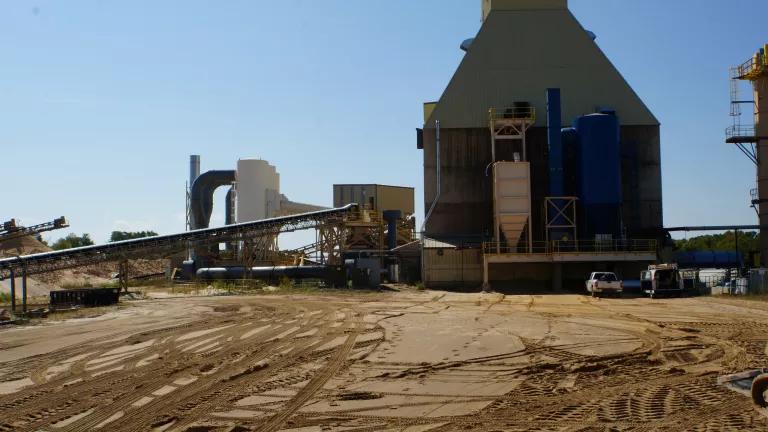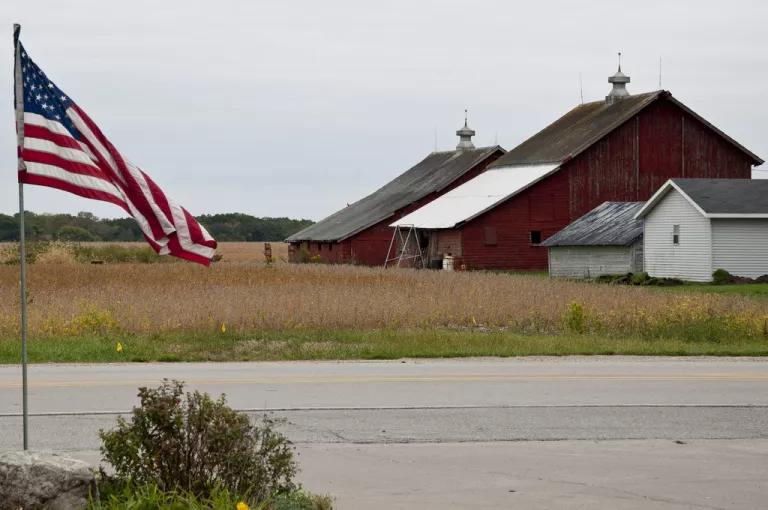Companies Mining Sand for Oil and Gas Threaten Midwest Fields, and Farmers Are Fighting Back
A group of Illinois landowners have waged a legal battle against a fracking company to protect their agricultural community.

A frack sand mine and processor site in Jordan, Minnesota
Nancy Loeb is waiting patiently for a decision two and a half years in the making. Within the next couple of months, the director of the Environmental Advocacy Center at Northwestern University will know if her clients—more than a dozen farmers from Waltham Township, Illinois—can use the legal system to fight Aramoni, a company planning to dig a sand mine into the fertile soil near their farms. The sand, used in the process of hydraulic fracturing to extract oil and gas from underground shale formations, is a valuable commodity these days. But so, argue the farmers, is the farmland.
If a panel of judges decides in the farmers’ favor, the landowners will press their case further in court, arguing that they should have a say in how the land is used. Farmland and the agrarian lifestyle, they say, are just as important as the sand used to extract fossil fuels. Indeed, they say they’ll take their fight all the way to the state’s supreme court if they have to.
A mine in LaSalle County’s Waltham Township would change the community forever, says one of the lead plaintiffs, Mary Whipple, whose husband, Monty, farms 800 acres there. At the sites of nearby sand mines, layers of rich earth—considered to be some of the most fertile topsoil in the country—is stripped away. Blasts from explosives used to loosen the sand deposits below the surface rattle nearby houses, and stadium lighting brightens the night sky. Silica, a known carcinogen, gusts through windows and settles on buildings. Noisy truck traffic kicks up more clouds of dust, and groundwater supplies dwindle; an individual mine can draw up to two million gallons of water a day.
Although research into whether frack-sand mines pose a threat to the health of those living near them is inconclusive, the farmers are still worried about the effects of the proposed mine in their community. Crispin Pierce, a toxicologist at the University of Wisconsin–Eau Claire, sampled the air around frack-sand mines and found that at five of six sites, the level of particulate matter 2.5 microns in diameter or smaller was higher than the U.S. Environmental Protection Agency’s acceptable level of 12 micrograms per cubic meter. Health effects of silica exposure include cardiovascular disease, lung disease, and lung cancer, warns the U.S. Occupational Safety and Health Administration.
Yet silica dust, which could wreak havoc on communities, is largely unregulated once the blasting starts and the plumes of dust rise, says Whipple. “There’s nothing to protect me and my friends,” she says. “What are we supposed to do? You get out your vacuum.”
Once mined, farmland can never be restored. On a 2014 flyover of LaSalle County—home to Starved Rock State Park, one of Illinois’ most visited natural attractions—a Chicago Tribune reporter described a patchwork landscape scarred by open pits. Concerned about the impact of sand mines on the environment and economy, the county placed a moratorium on new operations in 2013. But villages within the county, lured by the prospect of new jobs and fees paid by the mining companies, have annexed hundreds of acres of farmland, effectively overriding the county’s ban and excluding farmers who live outside the border from the decision making.

In the case of the proposed new Aramoni mine in Waltham Township, a local farmer sold his property to a developer, reportedly under the impression that it would be used for nonindustrial purposes. The village of North Utica then annexed the property, and four of the village’s six elected council members voted to grant the mining company a permit to operate there, despite the protests of more than 250 farmers. The council members now hold the power to preserve the land, Loeb says, or “subject it to the ups and downs and vagaries of a very cyclical business like fossil fuel drilling.”
Midwestern soils are some of the richest in the country, in part because of the layers of sand they contain. The grains found in Illinois, known as northern white, are round and uniform and help form soil that is ideal for growing corn and soybeans. Yet the soft white sand’s characteristics also make it nearly perfect for pumping, along with a high-pressure brew of toxic chemicals, into shale formations to open them up for oil extraction.
Communities in Minnesota and Illinois have lived amicably for more than a century with mines that provide sand used in the manufacturing and cement industries. But with the explosive growth of fracking, a Midwest “sand rush” was born. Before the recent collapse of oil prices, Wisconsin had 129 industrial sand processing facilities, up from just 5 in 2010. In LaSalle County alone, mining companies bought 3,100 acres of farmland between 2005 and 2014, according to the Chicago Tribune.
The Waltham Township farmers’ first attempt to take the village to court over the latest proposed mine fizzled after they failed to follow the proper procedure. It was only last month that an appellate court heard their case again, thanks in part to Loeb, who has environmental law experience. Three judges will decide whether they have standing to fight the village of North Utica’s council members and have a say in what happens to the land. “Instead of having a seat in the audience,” says Whipple, “I think we deserve a seat at the table.”
Although many mining companies either halted production or temporarily stopped mining sand when the price of oil plummeted, prices are already creeping higher. If the Waltham Township farmers are successful, they could provide a model for how other farmers can fight the frack-sand industry and prevent it from taking over their communities, says Loeb. “It’s really more and more about a big industry and some individuals profiting hugely at the expense of other people’s lives.”
This article was originally published on onEarth, which is no longer in publication. onEarth was founded in 1979 as the Amicus Journal, an independent magazine of thought and opinion on the environment. All opinions expressed are those of the authors and do not necessarily reflect the policies or positions of NRDC. This article is available for online republication by news media outlets or nonprofits under these conditions: The writer(s) must be credited with a byline; you must note prominently that the article was originally published by NRDC.org and link to the original; the article cannot be edited (beyond simple things such grammar); you can’t resell the article in any form or grant republishing rights to other outlets; you can’t republish our material wholesale or automatically—you need to select articles individually; you can’t republish the photos or graphics on our site without specific permission; you should drop us a note to let us know when you’ve used one of our articles.

Keystone XL, Take Two
Offshore Drilling 101
The Long, Long Battle for the Arctic National Wildlife Refuge